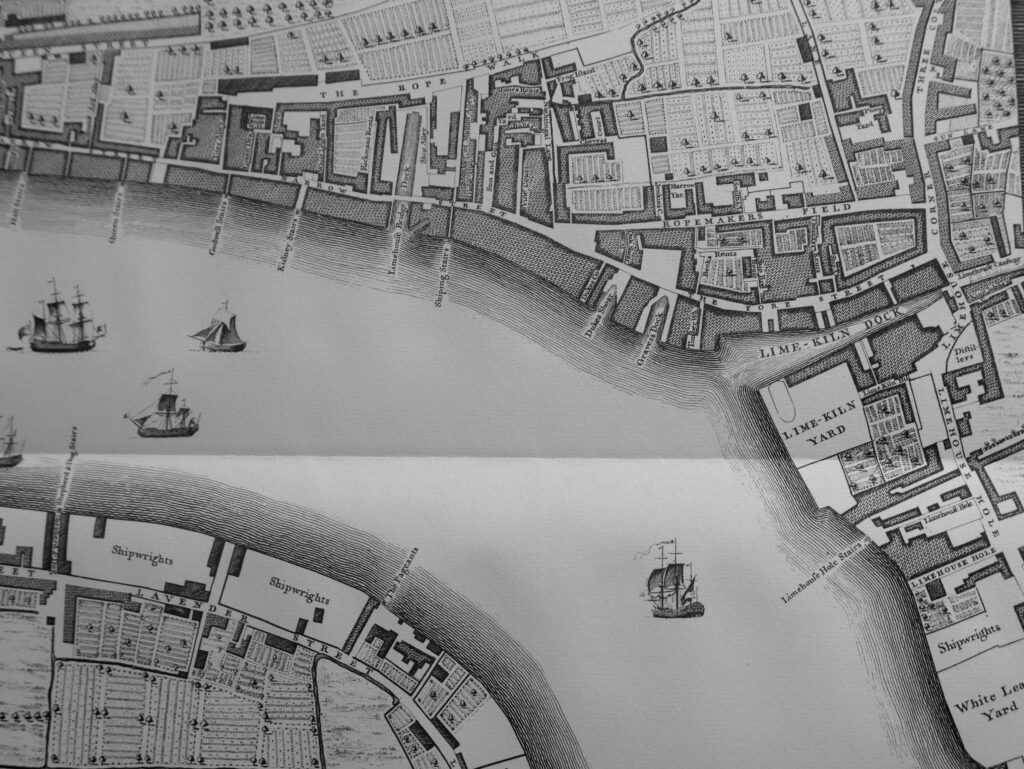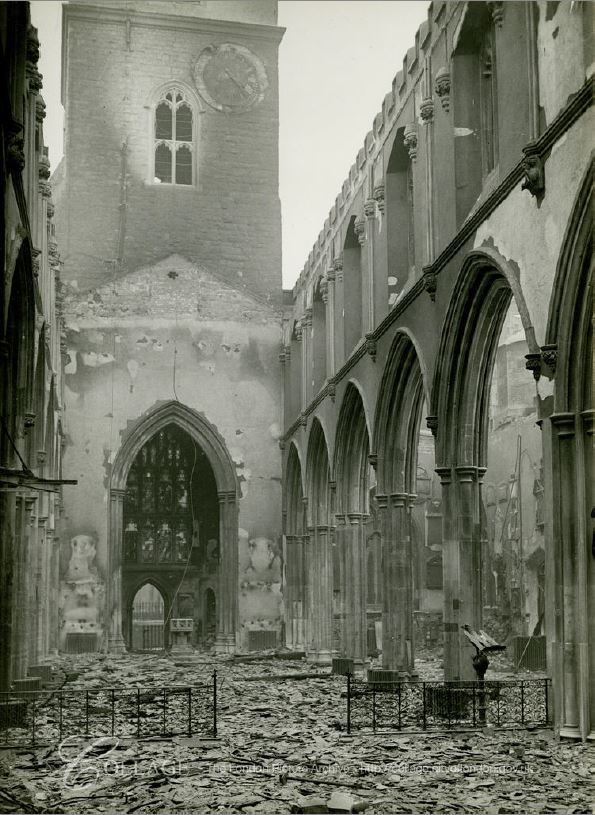The modest entrance to this church is so deceptive …

Nothing prepares you, as you climb the 13 steps, for what you will shortly encounter when you enter …

The majestic space within…

The dome is Wren’s finest and based on his original design for St Paul’s …

Wren lived at number 15 Walbrook and took special care in rebuilding this, his parish church, between 1672 and 1679, after the previous 15th century church was destroyed in the Great Fire. By the 18th century, the building was world famous, the Italian sculptor/architect Antonio Canova declaring, ‘We have nothing to touch it in Rome.’ And the architectural historian Nikolaus Pevsner lists it as one of the ten most important buildings in all of England.
Before considering the church as it looks now, you might be interested in its layout before the box pews were removed in 1888. This image, held by the Metropolitan Museum of Art in New York and dated 1809, shows a service in progress with figures in the pews listening to a minister in a pulpit to the right of the altar …

In 1987 the church was rearranged around a central, circular, polished stone altar, made of travartine marble by the famed sculptor Henry Moore. Patrick Heron (1920-1999) was one of Britain’s foremost abstract painters and he designed the colourful kneelers …


The idea was that the community would gather around it and for its central position to represent how the Gospel was central to their lives.
It went against the Christian tradition of having the altar at the Eastern end of the church and so naturally there was huge opposition to idea from some. The case ended up being taken to the Ecclesiastical courts where it was found to be acceptable.
The pulpit and font cover are attributed to the carpenters Thomas Creecher and Stephen Colledge, and the carvers William Newman and Jonathan Maine …


Look back towards the entrance to the church to see the rather magnificent organ case above the door. This dates from 1765 …

I took a prowl around the monuments and was stopped in my tracks by this one to John Lilburne (d.1678), citizen and grocer, of the Lilburn family of Sunderland, and his wife Isabella. It’s the earliest monument in the Church …

I love the little standing figures of the couple, he with cloak and long flowing hair above a tunic, with big cuffs and slender shoes, she a slim figure with long, flaring skirt, puffed out bodice and drapes over and behind her head. A charming pose with her arms crossed in front of her.
But what really caught my eye was the memento mori, a sculpture of a woman dancing with Death, who is a skeleton wearing a long skirt …

Then there’s George Alfred Croly of the Bengal Light Infantry who fell ‘gloriously by a cannon shot’ in the ‘assault on the entrenched camp of the sikhs’ in 1845, aged only 23 …

Robert Marriott’s splendid memorial …

Robert Marriott was Rector from 1662 until he died in 1689 aged 81
years. His monument in Latin describes him as ‘Professor of theology
and the watchful pastor of this Church. A man as a preacher so truly
Divine that by his preaching he at once charmed and convinced his
hearers. A man in whose character old time integrity was so tempered
with a sweetness that he made simplicity loveable. A man of so
spotless a life that his own example confirmed and recommended what
his lips taught.’ Praise indeed.
A long, rather touching inscription for Sir Samuel Moyer …


Many memorials of the time provide an insight into the dreadful child mortality rates of earlier centuries, even for those who were affluent. The tablet states that Samuel Moyer was a Baronet. He must have had money as the tablet states the family spent the summer at their home at Pitsey Hall in Essex and the winters in the parish of St Stephen Walbrook.
A Baronet who could afford homes in Essex and London still suffered numerous child deaths. Of their eleven children, eight died in their minority, with only three daughters surviving to “lament with their sorrowful mother, the great loss of so indulgent a father”.
The bust of Percivall Gilbourne …

Described in the excellent Bob Speel website as follows: ‘A short Latin inscription on a panel with a colourful marble surround … We see a noble bewigged head of an ageing man, firm of countenance and strong of neck, but with something of a jowl, above shoulders and chest wearing a drape rather than contemporary clothing’.
I make no apology for writing again about this brave man ..

Nathaniel Hodges was a 36-year-old doctor practising in London when the terrible plague of 1665 reached the City. Its arrival prompted a flight from London and, Hodges recalled later, this included four-fifths of the College of Physicians. The City was awash, he said, with ‘Chymists’ and ‘Quacks’ dispensing, as he put it: ‘… medicines that were more fatal than the plague and added to the numbers of the dead.’
Dr Hodges decided to stay and minister to his patients and first thing every morning before breakfast he spent two or three hours with them. He wrote later …
Some (had) ulcers yet uncured and others … under the first symptoms of seizure all of which I endeavoured to dispatch with all possible care …
hardly any children escaped; and it was not uncommon to see an Inheritance pass successively to three or four Heirs in as many Days.
After hours of visiting victims where they lived he walked home and, after dinner, saw more patients until nine at night and sometimes later.
He survived the epidemic and wrote two learned works on the plague. The first, in 1666, he called An Account of the first Rise, Progress, Symptoms and Cure of the Plague being a Letter from Dr Hodges to a Person of Quality. The second was Loimologia, published six years later …

A later edition of Dr Hodges’ work, translated from the original Latin and published when the plague had broken out in France.
It seems particularly sad to report that his life ended in personal tragedy when, in his early fifties, his practice dwindled and fell away. Finally he was arrested as a debtor, committed to Ludgate Prison, and died there, a broken man, in 1688.
The Latin on his memorial translates as follows:
Learn to number thy days, for age advances with furtive step, the shadow never truly rests. Seeking mortals, born that they might succumb, the executioner comes from behind. While you breathe you are a victim of death; you know not the hour in which your fate will call you. While you look at monuments, time passes irrevocably. In this tomb is laid the physician Nathaniel Hodges in the hope of heaven; now a son of earth, who was once a son of Oxford. May you survive the plague by his writings. Born 13 September AD 1629 Died 10 June 1688.
There are two glass display cases in the church.
This model allows the overall design of the church to be appreciated, not easy when viewed from outside …

For example. this is the view from the south …

Inside in another glass case you’ll see this famous phone …

You can read more about it and Dr Varah in my April 2018 blog.
As you leave and walk down the steps, look to your left and you will see a modern mosaic of St Stephen …

I would like to finish with a quotation that I particularly like from the church’s own publication setting out its history.
Wren considered geometry to be the basis of the whole world and the manifestation of its Creator, while light not only made that geometry visible but also represented the gift of Reason, of which geometry was for him the highest expression. Like the solution to a mathematical problem, everything fits into place with apparent simplicity; yet this simplicity itself is mysterious and magical. Whether one experiences St. Stephen’s alone, in stillness and quiet, or in a full congregation resounding with music, the effect is always the same. Life outside is complicated and chaotic. To enter is not to escape into fantasy; rather is it to submit to the strongest positive assertion of the true order of the universe.
Remember you can follow me on Instagram …




















































































































































































































































































































































































































































































